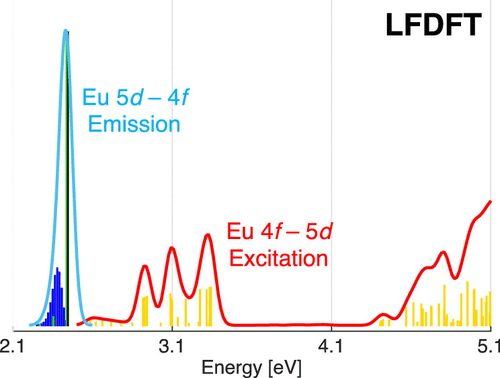当前位置:
X-MOL 学术
›
J. Phys. Chem. A
›
论文详情
Our official English website, www.x-mol.net, welcomes your
feedback! (Note: you will need to create a separate account there.)
Electronic Structure and Photoluminescence Properties of Eu(η9-C9H9)2.
The Journal of Physical Chemistry A ( IF 2.7 ) Pub Date : 2019-12-17 , DOI: 10.1021/acs.jpca.9b09755
Harry Ramanantoanina 1 , Lynda Merzoud 2 , Jules Tshishimbi Muya 3, 4 , Henry Chermette 2 , Claude Daul 5
The Journal of Physical Chemistry A ( IF 2.7 ) Pub Date : 2019-12-17 , DOI: 10.1021/acs.jpca.9b09755
Harry Ramanantoanina 1 , Lynda Merzoud 2 , Jules Tshishimbi Muya 3, 4 , Henry Chermette 2 , Claude Daul 5
Affiliation

|
The electronic structure of Eu2+ compounds results from a complex combination of strongly correlated electrons and relativistic effects as well as weak ligand-field interaction. There is tremendous interest in calculating the electronic structure as nowadays the Eu2+ ion is becoming more and more crucial, for instance, in lighting technologies. Recently, interest in semiempirical methods to qualitatively evaluate the electronic structure and to model the optical spectra has gained popularity, although the theoretical methods strongly rely upon empirical inputs, hindering their prediction capabilities. Besides, ab initio multireference models are computationally heavy and demand very elaborative theoretical background. Herein, application of the ligand-field density functional theory (LFDFT) method that is recently available in the Amsterdam Modeling Suite is shown: (i) to elucidate the electronic structure properties on the basis of the multiplet energy levels of Eu configurations 4f7 and 4f65d1 and (ii) to model the optical spectra quite accurately if compared to the conventional time-dependent density functional theory tool. We present a theoretical study of the molecular Eu(η9-C9H9)2 complex and its underlying photoluminescence properties with respect to the Eu 4f-5d electron transitions. We model the excitation and emission spectra with good agreement with the experiments, opening up the possibility of modeling lanthanides in complex environment like nanomaterials by means of LFDFT at much-reduced computational resources and cost.
中文翻译:

Eu(η9-C9H9)2的电子结构和光致发光性能。
Eu2 +化合物的电子结构是由强相关电子和相对论效应以及弱的配体-场相互作用的复杂组合产生的。随着当今的Eu2 +离子在照明技术中变得越来越重要,人们对计算电子结构引起了极大的兴趣。近来,尽管理论方法强烈依赖于经验输入,从而阻碍了其预测能力,但对半经验方法进行定性评估电子结构和对光谱进行建模的兴趣已经普及。此外,从头开始多引用模型的计算量很大,并且需要非常详尽的理论背景。在此处,在阿姆斯特丹建模套件中最近可用的配体场密度泛函理论(LFDFT)方法的应用显示:(i)根据Eu构型4f7和4f65d1的多重能级阐明电子结构性质,以及( ii)与传统的随时间变化的密度泛函理论工具相比,可以非常准确地对光谱建模。我们目前对Eu(η9-C9H9)2分子及其相对于Eu 4f-5d电子跃迁的潜在光致发光性质进行理论研究。我们对激发和发射光谱进行建模,使其与实验吻合良好,从而为在复杂环境(如纳米材料)中利用LFDFT对镧系元素进行建模提供了可能性,从而大大减少了计算资源和成本。(i)根据Eu构型4f7和4f65d1的多重能级阐明电子结构性质,以及(ii)与常规的随时间变化的密度泛函理论工具相比,可以非常准确地对光谱进行建模。我们目前对Eu(η9-C9H9)2分子及其相对于Eu 4f-5d电子跃迁的潜在光致发光性质进行理论研究。我们对激发和发射光谱进行建模,使其与实验吻合良好,从而为在复杂环境(如纳米材料)中利用LFDFT对镧系元素进行建模提供了可能性,从而大大减少了计算资源和成本。(i)根据Eu构型4f7和4f65d1的多重能级阐明电子结构性质,以及(ii)与常规的随时间变化的密度泛函理论工具相比,可以非常准确地对光谱进行建模。我们目前对Eu(η9-C9H9)2分子及其相对于Eu 4f-5d电子跃迁的潜在光致发光性质进行理论研究。我们对激发和发射光谱进行建模,使其与实验吻合良好,从而为在复杂环境(如纳米材料)中利用LFDFT对镧系元素进行建模提供了可能性,从而大大减少了计算资源和成本。
更新日期:2019-12-18
中文翻译:

Eu(η9-C9H9)2的电子结构和光致发光性能。
Eu2 +化合物的电子结构是由强相关电子和相对论效应以及弱的配体-场相互作用的复杂组合产生的。随着当今的Eu2 +离子在照明技术中变得越来越重要,人们对计算电子结构引起了极大的兴趣。近来,尽管理论方法强烈依赖于经验输入,从而阻碍了其预测能力,但对半经验方法进行定性评估电子结构和对光谱进行建模的兴趣已经普及。此外,从头开始多引用模型的计算量很大,并且需要非常详尽的理论背景。在此处,在阿姆斯特丹建模套件中最近可用的配体场密度泛函理论(LFDFT)方法的应用显示:(i)根据Eu构型4f7和4f65d1的多重能级阐明电子结构性质,以及( ii)与传统的随时间变化的密度泛函理论工具相比,可以非常准确地对光谱建模。我们目前对Eu(η9-C9H9)2分子及其相对于Eu 4f-5d电子跃迁的潜在光致发光性质进行理论研究。我们对激发和发射光谱进行建模,使其与实验吻合良好,从而为在复杂环境(如纳米材料)中利用LFDFT对镧系元素进行建模提供了可能性,从而大大减少了计算资源和成本。(i)根据Eu构型4f7和4f65d1的多重能级阐明电子结构性质,以及(ii)与常规的随时间变化的密度泛函理论工具相比,可以非常准确地对光谱进行建模。我们目前对Eu(η9-C9H9)2分子及其相对于Eu 4f-5d电子跃迁的潜在光致发光性质进行理论研究。我们对激发和发射光谱进行建模,使其与实验吻合良好,从而为在复杂环境(如纳米材料)中利用LFDFT对镧系元素进行建模提供了可能性,从而大大减少了计算资源和成本。(i)根据Eu构型4f7和4f65d1的多重能级阐明电子结构性质,以及(ii)与常规的随时间变化的密度泛函理论工具相比,可以非常准确地对光谱进行建模。我们目前对Eu(η9-C9H9)2分子及其相对于Eu 4f-5d电子跃迁的潜在光致发光性质进行理论研究。我们对激发和发射光谱进行建模,使其与实验吻合良好,从而为在复杂环境(如纳米材料)中利用LFDFT对镧系元素进行建模提供了可能性,从而大大减少了计算资源和成本。




































 京公网安备 11010802027423号
京公网安备 11010802027423号